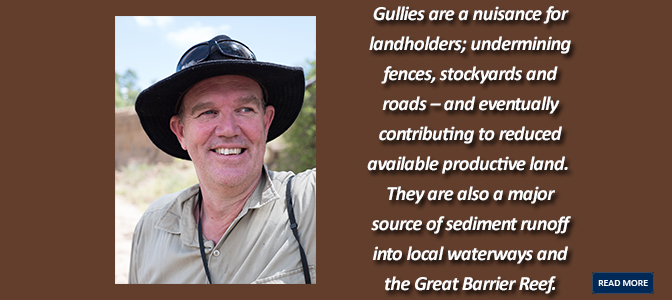
Associate Professor Andrew Brooks – Griffith Centre for Coastal Management – Griffith University
Gullies are a nuisance for landholders; undermining fences, stockyards and roads – and eventually contributing to reduced available productive land. They are also a major source of sediment runoff into local waterways and the Great Barrier Reef.
Gullies are a natural landscape process that has been accelerated by human activity over the last 100-150 years. Some soil types are particularly susceptible to erosion, and some of the soil in the Bowen, Broken, Bogie (BBB) catchments near Collinsville is highly-dispersive and unstable.
The problem is that it only takes a small disturbance in the protective top soil for water to get in and expose the subsoils, which literally dissolve on contact, ending up with large expanses of gullies. If left untreated, they will continue to erode until there is no material left.
Landholders can manage many smaller gullies fairly easily using techniques ranging from increasing ground cover and reducing local grazing pressure, to stabilising with hay bales and rock check dams.
Once they get too large they become harder, if not impossible for graziers to manage, and require specialist engineering solutions. These larger, what we call alluvial gullies are found on maybe less than 0.2 per cent of the total landscape but could be delivering up to 50 per cent or more of the total sediment load in the BBB region.
Most of these big gullies first formed more than 100 years ago when grazing first began in the region. They require specialist management, but have to be addressed to achieve the water quality improvements the Landholders Driving Change project is aiming for.
This project is different and a great model because all stakeholders groups are coming together around the table at the outset to share knowledge and gain a common understanding of the problem.
During this project, we’ll have the chance to better understand the kind of gullies out there, where they are, how best to fix them, and how much that might cost.
We’ll be trialling a range of methods to tackle all types of gullies – there is no “one size fits all” strategy. I believe no gully is unmanageable as long as we apply the right techniques. As we get better and more efficient we hope to deliver these solutions at reduced costs.
As we set out to repair existing gullies it’s crucial that activities such as road building or inappropriate powerline maintenance practices don’t create new ones.
Andrew is working alongside graziers, scientists and technical experts to design land condition and water quality improvement solutions in the BBB catchments near Collinsville, under the Queensland Government-funded Landholders Driving Change project.
